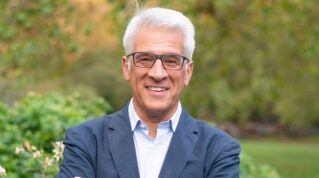As concern mounts over the impact of smartphones, Jessica Hill investigates what being a ‘phone free school’ really means.
When a pupil developed an addiction to pornography after seeing it for the first time on a school trip, Fulham Boys School headmaster David Smith found it “outrageous that this happened on my watch”. He then banned smartphones from school grounds and excursions for secondary school pupils.
If parents wanted their child to have a phone from now on, it had to be a ‘brick’, capable only of making and taking calls and texts.
He revealed his older pupils “grumbled”, but Smith got his “first ever round of applause” from parents of his younger cohort.
Just one in seven secondaries have a blanket ban on mobile phones, Teacher Tapp surveys suggest. Around half trust pupils to keep their phone on them but not use them without permission.

It’s a fragile trust. In October, 60 per cent of secondary teachers in schools banning smartphones told Teacher Tapp they’d seen pupils using phones in the last week.
One in 10 spotted pupils taking phones out in their last lesson.
Baroness Thornhill, formerly pastoral head of Queens’ School in Bushey, Herts, told a recent House of Lords debate “parents would not be happy if their child had a bottle of vodka or a bag of weed in their school bag. But the phone sits there capable of creating the same cravings, desires and addiction”.
Teacher Tapp’s latest survey data reveals schools have tightened up policies, particularly since the last government set guidelines in February that schools should “prohibit” the use of mobiles “throughout the school day”.
Whereas in January 2023 one in five secondaries allowed pupils to use phones during break and lunchtimes, last month it was around one in 10. Meanwhile, three-quarters of primaries now collect phones from pupils each morning.
But despite promising to do so, the last government swerved mandating phone bans.
Labour MP and former teacher Josh MacAlister put the issue back on the table in October, but the new government would also not back a ban.

Behaving badly
There is a cocktail of concerns about the use of phones in schools.
Behaviour is a big one. The percentage of secondary school permanent exclusions due to ‘inappropriate use of social media or online technology’ rose from 0.54 to 0.86 per cent in the year to autumn 2023-24.
Smartphones are also increasingly being used to cheat. GCSE and A-level exam malpractice using mobiles and other communication devices jumped 69 per cent between 2018 and 2023.
And there is widespread concern about the impact of smartphones on mental health. The harmful material Smith’s pupils have accessed through smartphones includes “county lines, sexting, grooming, self-harm, suicide attempts”, and “huge amounts of pornography”.
Rates of mental illness among young people have risen alongside rates of social media usage, with 796,445 under 18s accessing NHS community mental health support in November, up 15.1 per cent in two years. Psychologist Jonathan Haidt blames social media for the rise; his book The Anxious Generation influenced headteachers in all the schools we contacted who imposed complete smartphone bans.

A documentary aired this week on Channel Four, Swiped: the school that banned smartphones, tried to quantify the impact of phones on teenagers’ wellbeing by taking devices away for 21 days.
University of York researchers found the Year 8 pupils who took part at Stanway School in Colchester, Essex, showed 17 per cent less anxiety-related symptoms, 18 per cent less depression and 3 per cent better memory recall. Typically, the 30 participants slept an hour extra each night. Head of school John Player told Schools Week he noticed “better eye contact and alertness”.

He’s much more concerned about smartphone addictions than cyberbullying. His pupils are receiving up to 2,000 messages a day, with “phones dinging through the night”. He adds: “The time they’ll spend on fairly insular activities online becomes more important to them than their education.”
One participant, Jessica, felt pressure to go on her phone to keep her Snapchat streaks (the number of exchanges) up, because “I feel like it’s mean if you don’t. It looks like you’re ignoring someone and not being kind.”
Phil Arrowsmith, headteacher at Wirral Hospitals’ School, in Birkenhead, reported a “huge increase” in referrals from young people “simply unable to stop themselves from going onto social media, oversharing, and exacerbating small friendship issues”.
Confiscation tools
Different tools are being used by schools enforcing complete bans to lock phones away.

At Oasis Academy John Williams in Bristol, headteacher Victoria Boomer-Clark tried to stamp out phone use at school in 2022 by getting staff to line pupils up and place phones in boxes as they entered school. This was “heavy” on staff time, so instead the school (along with another Oasis academy, Coulsdon in Surry) introduced ‘cool lockers’, costing £15,000 including installation, to lock them up.
Since then, John Williams has seen a “dramatic fall” in “inflammatory use of social media”, although incidents still happen outside school.
But Stanway’s deputy head Rachel Braniff said she previously worked in a school that took phones from pupils during the school day and claimed it “didn’t make a difference to phone use, anxiety and bullying. They just did it all after school which was more intense. At 3.10pm they were bombarded with 300 messages.”
And Player believes pupils get around phone confiscations by bringing more than one phone into school.
He said: “We’ve all probably got a drawer at home with enough phones to fill a box. How many students are actually handing in an old phone that’s not being used?”

He’s shunned investing in lock-ups for smartphones (saying it’s too pricey), but has stepped up restrictions. Whereas before September pupils could keep phones in their pockets, they must now be kept in bags.
Notley High School in Braintree, Essex, and New Heights School in Liverpool use ‘screening’ wands – ordinarily used by police and security guards to scan for knives – to check for mobiles and other metal items.
Meanwhile, schools are becoming aware of pupils using smartwatches to do activities they would otherwise do on smartphones, such as sending messages, taking photos or videos and playing games. Many schools – including the 14 that are part of the Central Region Schools Trust – have tweaked policies accordingly to apply to all electronic devices.

Several schools have invested in pouches from US company Yondr that pupils lock their smartphones and smartwatches in. John Wallis Academy in Ashford, Kent, introduced the pouches in January at a cost of £32,000 (£20 each).
Headteacher Damian McBeath said it is “psychologically a big thing for kids to have to hand across their smartphones”, whereas the pouches mean they keep their property with them. “It’s a simple system that students can pretty much run themselves.”
The move led to 82 per cent less sanctions being issued and a 75 per cent drop in truancy as of September. Staff turnover went from 29 per cent in 2022-23 to 17 per cent in 2023-24, and incidents of bullying, harassment and online abuse are at a five-year low.
Hampton Court House school principal Katherine Vintiner said introducing pouches led to pupils’ “increased focus in class and improved communication”.
But it isn’t fool-proof. John Wallis pupil Daniel admitted some kids “manage to get their phones out” during the day, although “they’re not using them half as often as they used to”.

Yondr spokesperson Lizzie Hacking said: “You’re always going to get a very small percentage of students who try to break the rules.”
Pupil-parent resistance
Youngsters have used TikTok to protest phone restrictions. In March, pupils at Valley Park School in Maidstone, Kent, (part of Valley Invicta Academies Trust) posted videos viewed almost 80,000 times announcing a protest over (among other things) their right to “use mobile phones at lunchtimes and break times”.
Similarly, pupils at Barr Beacon School in Walsall, West Midlands, which implements a strict ‘no mobiles’ policy, roused support to “stand up and let ourselfves [sic] bring our phones” to school, with a video featuring a picture of its headteacher Kate Hibbs.
One comment read: “Like, I always have to sneak my phone in Barr Beacon, it’s so annoying. Like, why don’t they let us?”
The enforcement of bans can also concern parents. Theresa Kerr, a partner at Winckworth Sherwood law firm, “occasionally” sees “complaints” where phones are “confiscated… and the parent believes that the school’s approach is disproportionate”.
Barr Beacon has suffered instances of parents questioning its phone policy and threatening staff with the police. Hibbs wrote to parents telling them that “the police will support us fully in searching pupils for prohibited items and confiscating them”.

The ‘not seen or heard’ phone ban in place at Bideford College in Devon, run by Athena Learning Trust, sparked anger from the mum of an additional needs pupil, Bex Stone, who told Schools Week there would be “hell to pay” if the school removed her daughter’s phone from her.
She said: “She panics if you take away her ability to speak to me. If she needs me, she’ll go to the toilet to message me and has even risked messaging under the desk on a really bad day.”
Bideford, like many schools, has inserted caveats into its policy allowing some pupils with additional needs to keep their phones on them.
Principal Claire Ankers considers phone policy breaches as “valuable learning opportunities, allowing staff the chance to help students better understand the reasons behind the rules and the consequences of not adhering to them”.
Social justice
Many of the schools facing the least resistance from parents to smartphone bans are in affluent areas.
Co-founder of Smartphone Free Childhood Clare Fernyhough said they had over 150,000 parents in their movement that aims to “empower all schools to go smartphone free”.
But all 10 areas of England with the highest numbers of parents who’ve signed their pact not to give children a smartphone until they’re in at least year nine are in the South. Three are in London, with Southwark being a stronghold of the movement.
Of it’s 20 state secondaries, 17 are implementing complete smartphone bans, with another, Haberdashers’ Borough Academy, being part of a nine-school MAT that’s considering it.
Fernyhough sees the geographic imbalance as “a social justice issue”. “We know that the kids from more deprived backgrounds are the most vulnerable online,” she said.

Embracing responsible use
But not all school leaders buy into the ‘phone-free schools’ movement.
Malmesbury School in Wiltshire, part of the Athelstan Trust and recently rated outstanding in all areas, allows pupils to keep mobiles with them and use them in break and lunchtimes. Although headteacher Brett Jouny worries over whether he’s made the right call (he’s reviewing the policy in January), he believes access to mobiles can be beneficial for neurodiverse pupils who “find school really dysregulating”.
He said “having half an hour at lunch” to play on their phones “calms them down, ready for the rest of the afternoon”.
However, it’s also a “lovely coincidence” that Malmesbury’s mobile reception is “horrendous” with access to 4G “impossible”.
Will Ruscoe, headteacher of Sir William Romney School in Tetbury, Glos, allows pupils to use smartphones “where the teacher feels there’s a task that the phone would benefit the learning”. That might include a “quick Google search” or “interactive quiz games”.
Highworth Grammar School in Ashford, Kent, allows mobiles and earbuds to be used in lessons with permission, and on “silent mode” the rest of the time.
Arrowsmith said Wirral Hospitals’ School used to allow pupils access to their devices so they could “learn how to manage their use and of the potential learning benefits of phones”. But in September he shifted to a “zero-tolerance approach… for both staff and students”.
He said some pupils had phone attachment issues and “their ‘need’ to have their phones is more genuine, and greater, than for the average young person”. But he added “the positives have far outweighed the negatives”.

Beyond bans
Meanwhile, some schools are also expanding efforts to urge families to restrict phone use at home.
After a pupil survey revealed over a third of Fulham Boys School pupils’ smartphones had unrestricted web access on them, Smith felt a “moral obligation” to take action, not just through the ban he’s enforcing but also by speaking to parents at coffee mornings.
City of London Academy Southwark is from next September encouraging Year 7s to only use brick phones, with the ambition that by 2027, Year 7 to Year 9 will only be allowed these phones at school. Principal Mike Baxter believes that for 95 per cent of the schools going “phone free,” the “impact is minimal”.
He says: “Despite the self-congratulatory headlines, these schools are not changing kids’ lives in the way they should be” because “the smartphones/social media battleground has never been in schools. It’s at 2am, when a notification leads to two hours on TikTok, [then…] come 9am, trying to stay awake in maths when they’re sleep deprived and hard wired to expect a dopamine hit.”

Headteacher Andrew O’Neill, of All Saints Catholic College in West London, doesn’t allow pupils’ smartphones to be switched on at school, but wants the narrative to be about “what you give pupils” rather than “banning and taking away”.
This year he ran extended 11-hour days for Year 7 and 8 pupils over two periods of 10 weeks and four weeks, giving them more opportunities to socialise away from screens. Assistant head Rebecca Fulla saw pupils rediscover the joys of hide and seek, chess and rounders, with Uno being “by far their favourite” game.
Player also believes the solution to smartphone addiction lies not in bans, but in educating parents to “control these devices”. “Parents want that advice and support. They want their children back, but they don’t know how to do this,” he says.

Meanwhile, almost three months after the Stanway experiment ended, the four pupils we spoke to all said they’re now using their phones less.
Miles, who had spent six hours a day on devices, now spends more time “playing chess” with his dad, who has banned him from using his phone upstairs.
At John Wallis Academy, deputy head Terri-Ann Smee sees pupils now bringing board games into school. Some are creating their own games.
Boomer-Clark said the “atmosphere” at John Williams has changed since smartphones were banned, with pupils at breaktimes “wanting to socialise and be present in that moment”.
Smith believes his blanket smartphone ban will reap dividends in the future, when “the average parent choosing this school will turn to their son and say, ‘I’m not going to buy you a smartphone because you’re going to Fulham Boys School.
“That will give them a few more years of their childhood back.”














Your thoughts